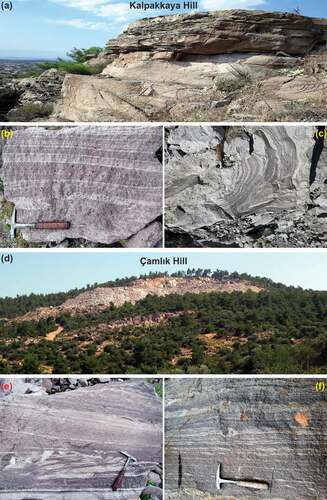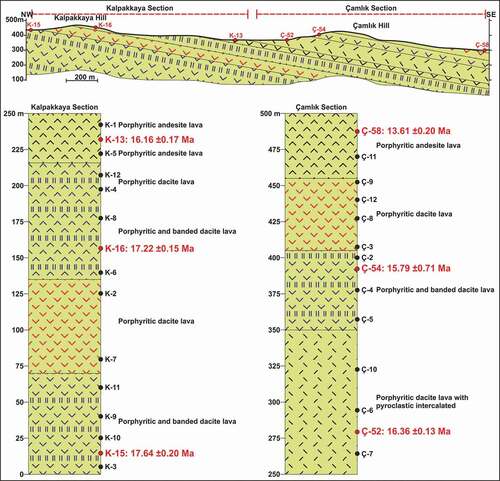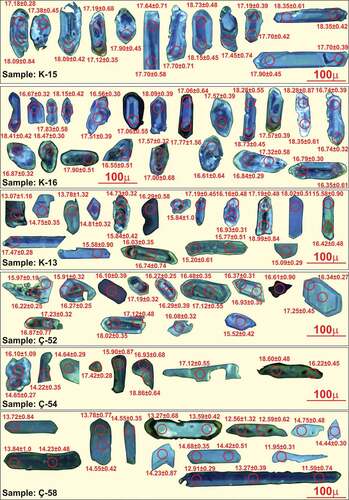ABSTRACT
There are a number of volcanic eruption centres that form large caldera structures, and possibly feeding from relatively large magma chambers during the Miocene period in Western Anatolia. One of them is Yuntdağ volcano, and its products have formed a thick volcanic succession covering large areas. In this study, an area where the volcanic sequence is seen well in the south-eastern part of the volcano was selected. Geochemistry and geochronology analyses were carried out along a line between Kalpakkaya and Çamlık Hills in order to better understand the petrological evolution of melting, assimilation, storage and homogenisation processes in the magma chamber (and/or chambers) feeding the volcano within a limited time period (~4 Ma). Samples acquired from the bottom, middle and upper portions of these sections display Early-Middle Miocene ages of 17.64 ± 0.20, 17.22 ± 0.15, 16.16 ± 0.17 and 16.36 ± 0.13, 15.79 ± 0.71 and 13.61 ± 0.20 Ma, respectively. Although, felsic crystal melts, magma mixing and multiple mafic inputs were the dominant processes, fractional crystallisation was less efficient. Also, geochemistry data also indicate that the studied volcanic rocks generated by the melting of the lithospheric mantle, by slab retreat and roll-back of the Hellenic – Cyprus slab, and evolved in shallow magma chambers during the Early – Middle Miocene.
1. Introduction
Western Anatolia comprises various magmatic units that were mainly generated by the Aegean Subduction system during the Cenozoic period (). The first magmatic products of this system were mainly generated at the Eocene time along the Biga Peninsula that compromises both plutonic and volcanic products. For the formation of Eocene magmatism, subduction-related, arc-continental collisions and post-collision tectonic setting models associated with the closure of the Neotethyan Ocean have been proposed by Şengör and Yılmaz (Citation1981), Delaloye and Bingöl (Citation2000), Köprübaşı and Aldanmaz (Citation2004), Ustaömer et al. (Citation2009), Altunkaynak et al. (Citation2012a), Prelević et al. (Citation2012), Ersoy and Palmer (Citation2013), and Ersoy et al. (Citation2017). In the Oligocene – Miocene magmatism became more prominent, and covered large areas at the south of İzmir – Ankara – Erzincan Suture Zone (IAESZ) in Western Anatolia. This magmatism represented by mainly calc-alkali, high-K calc-alkali volcanic and coeval I-type plutons, produced in relatively shallow magma chambers, has significant chemical heterogeneity. It carries traces of magma chamber processes such as fractional crystallisation, magma mixing/mingling, and crustal assimilation (Aldanmaz et al., Citation2000; Altunkaynak et al., Citation2012b; Aysal, Citation2015; Ersoy et al., Citation2010; Tatar Erkül et al., Citation2018). Also, volcanic products in that period often intercalated with the continental clastics and lacustrine sediments (Ercan et al., Citation1996; Ersoy et al., Citation2012a; Karaoğlu, Citation2014; Uzel et al., Citation2013). Meanwhile, this time corresponds to a period before a major shift in the tectonic development in Western Anatolia such as exhumation of the core complexes (i.e. Menderes massif) (Bozkurt & Park, Citation1994; Bozkurt & Satır, Citation2000; Bozkurt et al., Citation2011; Emre & Sözbilir, Citation1995; Erkül et al., Citation2005; Gessner et al., Citation2001; Jolivet & Brun, Citation2010; Jolivet et al., Citation2013; Karaoğlu, Citation2014; Ring et al., Citation2010; Üşümezsoy, Citation1988; Uzel et al., Citation2013; Van Hinsbergen et al., Citation2010, Citation2005), generation of the İzmir-Balıkesir Transfer Zone (Erkül et al., Citation2005), clockwise-rotational extension and related deformation in association with roll-back induced asthenospheric upwelling (Ersoy & Palmer, Citation2013), and production of the asthenospheric mantle-related alkaline volcanism (Grützner et al., Citation2013; Tokçaer et al., Citation2005).
Figure 1. A) Major tectono-stratigraphic units, and suture belts of Turkey (Okay & Tüysüz, Citation1999). b) Distribution of Oligocene – Miocene volcanic rocks in Western Anatolia (simplified from MTA 1/500.000 scaled geology map). Abbreviations: IPS: Intra-Pontide suture, IAES: 3 İzmir-Ankara-Erzincan suture, ITS: Inner Tauride suture
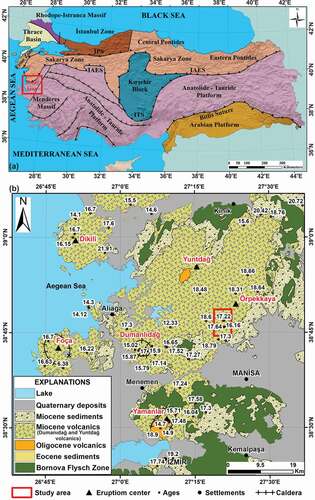
There are several volcanic eruption centres (i.e. Yamanlar, Foça, Dumanlıdağ, Örpekkaya, Dikili and Yuntdağ volcanoes) forming important large caldera structures, and possibly feeding from large magma chambers for the Western Anatolian Miocene magmatism (Akay & Erdoğan, Citation2004; Altunkaynak et al., Citation2010; Karaoğlu, Citation2014). This study examined two successive volcano-stratigraphic levels around the Karakılıçlı volcanic field (south-eastern part of the Yuntdağ volcano, north of Manisa, ), revealing the variation of the chemical compositions of these volcanic sequences, and aimed to understand the changes in a large magma chamber between 17.64 ± 0.20 Ma and 13.61 ± 0.20 Ma (at about 4 My) periods in the Western Anatolian Volcanic Province (WAVP). The different lava flows and pyroclastic units in the volcano-stratigraphic sections (the Kalpakkaya and Çamlık Hills ()) were sampled from bottom to top, and whole-rock geochemistry analysis were done. Moreover, it is the first time, zircon U-Pb dating for the studied volcanic successions have been conducted on lower, middle and upper portions in order to better correlation of the spatial and geochemical evolution of the volcanism in the region. The chemo-stratigraphy sections were prepared to understand the petrological evolution of melting, assimilation, storage and homogenisation (MASH) processes of the studied volcanic rocks.
Figure 2. Geological map of the study area (Adapted from Dönmez et al., Citation2014; Türkecan, Citation2015), coordinate system: WGS1984_UTM_Zone35N)
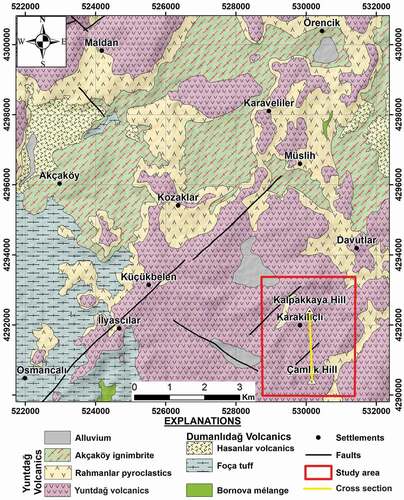
2. Materials and methods
2.1. Zircon U-Pb LA-ICP-MS geochronology
Six different samples were selected from the different layers of the two measured sections (three samples per each section) in the region. For each sample, 2 kg of samples were crushed in a jaw crusher, and their grain size was reduced below 250 microns. The sample size of 63 to 250 micron was selected for magnetic separator and heavy liquid (sodiumpolytungstate) to separate zircon minerals. Finally, hand-picked zircon grains mounted into the epoxy resins under a binocular microscope. After polishing, zircon grains imaged by using optical cathodoluminescent (Citl CL8200 Mk5-1) at the Istanbul Technical University, Geochemical Analysis Laboratories (ITU-JAL). By the guide of these images, the specific spot has been selected for geochronology analysis. Zircon U-Pb analyses were conducted by using Perkin Elmer NexION 2000 ICP-MS combined with the ESI NWR-213 solid phase laser established at the Geochronology and Geochemistry Laboratory of Istanbul University-Cerrahpaşa. Spot size of the zircon grains vary between 25 and 40 micron, and helium was used as carrier gas (0.5 l/sec). Zircon reference material 91,500 was selected as a primary standard, and AusZ-10 (38 Ma) and MudTank (750 Ma) as secondary reference materials. All the measurements were evaluated by the Iolite (version 2.5) data reduction software (Paton et al., Citation2011) package.
2.2. Whole-rock geochemistry
Twenty-three samples were selected for the whole-rock geochemistry analyses that represent the two different stratigraphic sections. The major oxides of these samples were analysed by the X-ray fluorescence (XRF) spectrometer (Bruker S8 Tiger Wavelength Dispersive XRF) at the Geochemistry Analysis Laboratory of Istanbul Technical University (ITU-JAL). The major oxide values were analysed on samples, which turn into fused glass discs that were created by the LiBO2 fusion in the platinum-golden crucibles. The loss on ignition values were calculated from the mass loss after the sample was heated for 2 hours at 1050°C. The trace and rare earth elements of these samples were measured by using a Perkin Elmer ELAN DRC-e at ITU-JAL, and Thermo XSeries II ICP-MS established at the Geochemistry Laboratory of General Directorate of Mineral Research and Exploration.
3. Geological background and petrography
3.1. Geological background
The study area crops out along the basement units of Bornova Flysch Zone (or Bornova melange), which are situated between the Menderes Massif and the Sakarya Zone (, b; Okay & Altıner, Citation2007; Okay et al., Citation2012). Bornova Flysch Zone consists of Mesozoic limestone blocks, mafic volcanics, radiolarites and serpentinite blocks that are embedded in a highly deformed sedimentary matrix (Brinkmann, Citation1966; Erdoğan, Citation1990). The three volcanic edifices in the region are called Yamanlar, Dumanlıdağ and Yuntdağ volcanoes (Akay & Erdoğan, Citation2004; Altunkaynak et al., Citation2010; Karaoğlu, Citation2014). Akay and Erdoğan (Citation2004) stated that the Dumanlıdağ volcanics are composed of three rock assemblages with lateral and vertical transitions such as Yuntdağ volcanics, Foça volcanics and Aliağa limestones. According to the authors, the Yuntdağ volcanics are located at the bottom and are predominantly composed of andesitic and trachyandesitic lava flows, domes and dykes, and interbedded pyroclastic flow deposits (Akay & Erdoğan, Citation2004). The Dumanlıdağ Volcanics is considered the stratigraphic equivalent of the Yuntdağ volcanics (Kaya, Citation1978; Ercan et al., Citation1985; Eşder et al., Citation1991; Dönmez et al., Citation2014 ()). Yuntdağ volcanics pass laterally and vertically into the Foça volcanics consisting of a thick rhyolitic pyroclastic sequence with small rhyolite domes and dykes (Akay & Erdoğan, Citation2004). This unit contains white-yellowish ignimbrites and rhyolitic lavas, which are intercalated with lacustrine clay and limestone units (Dönmez et al., Citation2017; Hasözbek, Citation2017; Kaya, Citation1978). This unit is overlain by the Hasanlar volcanics (Akçay et al., Citation2014; Kaya, Citation1978) that contain volcanic ash, block, lava breccia, tuff and lenticular limestone units together with more prominent basalt and pyroxene bearing andesite lavas (Akçay et al., Citation2014; Dönmez et al., Citation2017). Through the upper portion of the stratigraphy, Early-Middle Miocene aged Dumanlıdağ and Yuntdağ volcanics getting prominent and became the most widespread volcanic product around the region (Akyürek et al. Citation1978; Akay & Erdoğan, Citation2004; Dönmez et al., Citation2014, Citation1998; Türkecan, Citation2015).
The volcanic rocks in the study area belong to the Yundağ volcanics. The Yuntdağ volcanics composed of the sub-units of Rahmanlar pyroclastics (Akyürek et al. Citation1978) and Akçaköy ignimbrite member (Dönmez et al., Citation2014, Citation1998). All these units are intercalated with Middle-Upper Miocene continental and lacustrine sediments (Dönmez et al., Citation1998; Ercan et al., Citation1996; Kaya, Citation1978). The Yuntdağ volcanics consist of grey and reddish andesite, dacite, rhyodacitic lavas and pyroclastics (Akay & Erdoğan, Citation2004). Flow banding is common, and thorough the upper portion of the sections, glassy flow structure became dominant ().
3.2. Description of stratigraphic sections
In order to describe in detail, the south-eastern part of the Yuntdağ volcanics, two successive stratigraphic sections measured along a line between Kalpakkaya and Çamlık Hills (in the Karakılıçlı volcanic field) was prepared where the characteristics of the volcanic sequence are best preserved (), and samples were taken from volcanic rocks that different lithological features. The Kalpakkaya Hill section has been started with reddish-grey porphyritic dacite from the bottom ()). The section continues with porphyritic textured and banded dacitic lavas that consist of thin tuff interlayer. The section continues monotonously and displays approximately at 250-metres thicknesses. On the other hand, the Çamlık Hill section starts with porphyritic dacite with pyroclastic inliers in the bottom and overlain by porphyritic and banded dacite, contrary to Kalpakkaya Hill section, the reddish-brown and grey andesitic lavas are situated at the top of the section (, 4).
3.3. Petrography
Main mineral assemblages of the dacidic, and andesitic lavas observed in volcano-stratigraphy composed of plagioclase (oligoclase-andezine), hornblende (oxyhornblende and/or kaersutite), biotite, rarely clinopyroxene (in only andesitic lavas), a small amount of sanidine, and opaque minerals in glassy (rarely microlitic) groundmass (). They mainly display porphyritic, glomerulo porphyritic, vitrophyric and microlithic textures. Plagioclases are the main rock-forming minerals in lava samples, they show euhedral – subhedral shapes, twinning, and have oscillatory zoning. Hornblende is the most common dark-coloured mineral in lavas. Hornblendes are generally reddish brown in colour, and have euhedral – subhedral shapes, and are partially or completely oxidised phenocrysts from the edges. In some places they are in the form of ghost crystals due to being resorbed by magma. Biotite, is the second most common dark coloured mineral, it is fox red – reddish brown in colour, and consists of platy crystals with on direction cleave planes. In some places, radioactive halos are observed around zircon inclusions. Clinopyroxenes have only been seen in andesitic lavas, and are usually composed of small anhedral crystals. While the secondary mineral phase is represented by chlorite, calcite, and clay minerals, accessory phase represented by mainly zircon.
Figure 5. A-b) Oxyhornblende phenocryst with opaque margin, and entirely resorbed hornblende ghost crystals in porphyritic dacite (a: plain polarised light(PPL), and b: crossed polarised light (CPL)). c) Plagioclase, biotite and oxyhornblende crystals is in glassy groundmass (CPL). d) Oscillatory zoned plagioclase in dacitic lava. e-f) Plagioclase, biotite and oxyhornblende crystals in felsitic and glassy groundmass in glomeruloporphyritic andesite (CPL). Abbreviations: Pl: plagioclase, Hbl: hornblende, Bt: biotite
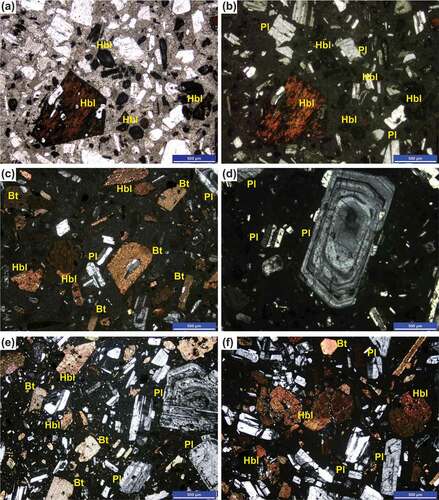
4. Results
4.1. Zircon U–Pb crystallisation ages
The selected zircon grains for dating mainly show transparent, pale brown colours and display prismatic shapes. CL images mostly display magmatic oscillatory zoning and mainly homogeneous (). Considering the CL images, both the core and edge zones of zircon grains were measured. In some zircon grains, measurements were made in different zones. No inherited zircon was found, and it was observed that measurements made in different zones were generally close to each other. The results of the zircon crystallisation ages for the Kalpakkaya and Çamlık Hill sections (three samples from lower, middle and upper levels per each section) are outlined below.
4.1.1. Section of Kalpakkaya Hill
Sample K-15 (lower part): The 206Pb/238U ages obtained from the K-15 samples display ages dispersed between 18.73 ± 0.48 Ma to 17.12 ± 0.35 Ma (). The Concordia age calculated as 17.64 ± 0.20 Ma and the mean age deduced as 17.68 ± 0.23 Ma ().
Figure 7. Zircon U-Pb Concordia diagrams of Kalpakkaya Hill and Çamlık Hill volcanic sections. Figure (a) and (d) are corresponding to lower parts, (b) and (e) are corresponding to middle parts and (c) and (f) are corresponding to upper parts of the sections
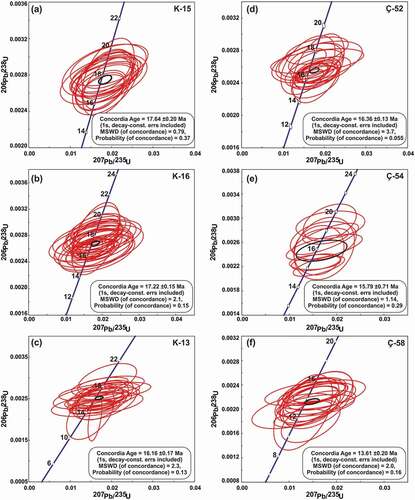
Sample K-16 (middle part): The 206Pb/238U ages obtained from the K-16 sample display ages dispersed between 18.73 ± 0.45 Ma to 16.35 ± 0.61 Ma (). The Concordia age calculated as 17.22 ± 0.15 Ma and the mean age deduced as 17.29 ± 0.26 Ma ().
Sample K-13 (upper part): The 206Pb/238U ages obtained from the K-16 sample display ages dispersed between 18.99 ± 0.84 Ma to 13.07 ± 1.16 Ma (). The Concordia age calculated as 16.16 ± 0.17 Ma and the mean age deduced as 16.22 ± 0.55 Ma ().
4.1.2. Section of Çamlık Hill
Çamlık Hill section displays quite similar age population like the Kalpakkaya Hill section.
Sample C-52 (lower part): The 206Pb/238U ages obtained from the C-52 sample display ages dispersed between 18.02 ± 0.35 Ma to 15.52 ± 0.42 Ma (5). The Concordia age calculated as 16.36 ± 0.13 and the mean age deduced as 16.44 ± 0.25 Ma ().
Sample C-54 (middle part): The 206Pb/238U ages obtained from the C-52 sample display ages dispersed between 18.86 ± 0.64 Ma to 14.22 ± 0.35 Ma (). The Concordia age calculated as 15.79 ± 0.71 and the mean age deduced as 15.9 ± 1.1 Ma ().
Sample C-58 (upper part): The 206Pb/238U ages obtained from the C-58 sample display ages dispersed between 14.75 ± 0.48 Ma to 11.59 ± 0.74 Ma (). The Concordia age calculated as 13.61 ± 0.20 and the mean age deduced as 13.69 ± 0.47 Ma ().
4.2. Whole rock geochemistry
The results of the major oxide and trace element analysis of twenty-three samples from Kalpakkaya and Çamlık Hill are given in . These volcanic rocks show narrow SiO2 contents ranging from 61.70 to 66.53 wt.%, TiO2 from 0.68 to 0.85 wt.%, Al2O3 from 13.88 to 16.77 wt.%, Fe2O3 from 4.48 to 6.19 wt.%, MgO from 1.10 to 2.28 wt.%, CaO from 2.86 to 5.80 wt.%, Na2O from 2.39 to 3.36 wt.% and K2O from 2.94 to 3.80 wt.% (). Na2O/K2O ratios of the Kalpakkaya Hill volcanic units are vary from 1.02 to 1.10, and they have slightly sodic character. In contrast, Çamlık Hill volcanic units display lower Na2O/K2O ratios and have more potassic character. Magnesium number (Mg#) of the samples are between 30 and 49 (Mg# = 100 x molar Mg/(Mg+Fe)). The results of the analysis are plotted in total alkali (Na2O+K2O) versus SiO2 discrimination diagram (Le Bas et al., Citation1986), the studied volcanic rocks mainly plot within the dacite, and rarely andesite fields (). On the K2O versus SiO2 diagram (Peccerillo & Taylor, Citation1976), all of the samples fall into the high – K calc-alkaline series field ().
Table 1a. Results of LA-ICP-MS U–Pb zircon ages of sample K-15
Table 1b. Results of LA-ICP-MS U–Pb zircon ages of sample K-16
Table 1c. Results of LA-ICP-MS U–Pb zircon ages of sample K-13
Table 1d. Results of LA-ICP-MS U–Pb zircon ages of sample Ç-52
Table 1e. Results of LA-ICP-MS U–Pb zircon ages of sample Ç-54
Table 1f. Results of LA-ICP-MS U–Pb zircon ages of sample Ç-58
Table 2. Whole-rock major (wt.%), trace (ppm) and rare earth elements (REE) (ppm) results of the studied volcanic rocks
Figure 8. A) Total alkali (Na2O + K2O) versus SiO2 (.Le Bas et al., Citation1986), and b) K2O versus SiO2 discrimination diagrams (Peccerillo & Taylor, Citation1976) for the classification of volcanic rocks. Western Anatolian Miocene volcanics data is taken from Ercan et al (Citation1985; Ercan et al., Citation1996), Innocenti et al. (Citation2005), Ersoy et al. (Citation2008), Ersoy et al. (Citation2012a), Helvacı et al. (Citation2009), Seghedi and Helvacı (Citation2016), Hasözbek (Citation2017)
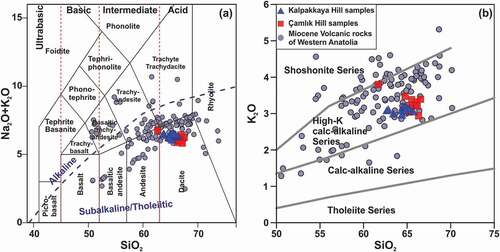
On N-type MORB normalised spider diagrams, all of the volcanic samples display apparent enrichment in LILEs (Large Ion Lithophile Elements; Sr, K, Rb, Ba, Th) and much lower but still prominent enrichment in LREEs (Light Rare Earth Elements; La, Ce and Nd). On the other hand, HFS (High Field Strength) elements (Tb, Ti, Y and Yb) show apparent depletion (). There is clear depletion through Th, Ta, and Nb and a similar depletion also be found through La to Nd (). In addition, Hf, Zr, and Sm elements display nearly flat patterns (). Even the Nb and Ta display very apparent depletion relative to the neighbouring elements, they still enriched relative to the N-MORB values (). The apparent Nb and Ta anomaly mainly attributed to the subduction-related arc settings while it may have been generated by the relict metasomatized portions generated in the collision-related settings.
Figure 9. (a) N-MORB (N-type mid-ocean ridge basalt), and (b) chondrite normalised spider diagrams of the Kalpakkaya and Çamlık Hill samples (normalised values are from Sun & MacDonough, Citation1989)

Chondrite normalised rare-earth element (REE) variation diagrams of the volcanic units display similar patterns for all series. In the selected units of the both volcanic sections, light rare earth elements (LREE) of the samples display relative enrichment regarding to the other elements and the majority of the heavy light rare earth elements (HREE) display similar values to the chondritic values (). Furthermore, in all series there is an apparent negative Eu anomaly (Eu/Eu* ratios ((Eu)cn/[(Sm)cn x (Gd)cn]0.5 stands for chondrite normalised) dispersed between 0.62 and 0.75). Also most of the middle rare earth elements show relative depletions compared to the LREE and HREE. Thus these features support the amphibole and feldspar fractionation of the studied volcanic units.
In tectonic discrimination diagrams of Pearce et al. (Citation1984) that using Nb vs Y values, our samples plotted along the volcanic arc granites (VAG) and syn-collisional granite field and one samples plotted along the within-plate field (). At the tectonic discrimination diagram of Harris et al. (Citation1986) that utilising Rb/30 -Hf- 3xTa; our samples dispersed along the volcanic arc and late and post-collisional fields (). The Th/Yb versus Ta/Yb (Schandl and Gorton Citation2002) reveal that the volcanic units were generated along the active continental margin (). These diagrams imply that the magma source area of the studied volcanic samples were affected by the subduction related modifications and possibly effected by crystal-related modifications.
Figure 10. Tectonic discrimination diagrams of a) Nb versus Y (Pearce et al., Citation1984), b) Rb/30-Hf-3xTa (Harris et al., Citation1986), and Th/Yb versus Ta/Yb (Schandl and Gorton Citation2002). Abbreviations: MORB: mid-ocean ridge basalts; VAG: volcanic arc granites; ORG: ocean ridge granites; WPG: within plate granites; syn-COLG: syn-collisional granites, WPE, within-plate enrichment, WPVZ: within plate volcanic zone, ACM: Active Continental margin, SZE, subduction zone enrichment; CC, crustal contamination; FC, fractional crystallisation; UC, average upper crust
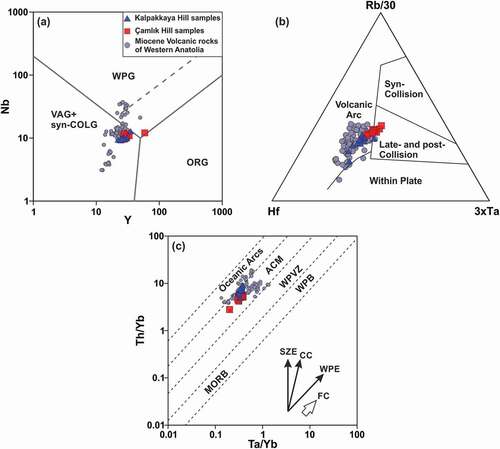
4.3. Chemo-stratigraphy
The volcanic rocks from the Kalpakkaya, and Çamlık Hill sections have mainly intermediate (mainly dacitic and rarely andesitic) composition. The Harker variation diagrams can be used to assess various magmatic evolutionary trends such as fractional crystallisation, mixing, assimilation and replenishment in magma chamber. SiO2 versus TiO2, Al2O3 and Fe2O3 binary diagrams imply mainly fractional crystallisation trends with the increasing of SiO2 content despite a bit scattering. On the other hand, SiO2 versus MgO, CaO, Na2O, K2O, Sc, Co and Zr binary diagrams () show disseminated patterns. Also, the evolutionary trends for the Ba, Rb, Sr and Y elements generally show flat trends (). However, chemo-stratigraphy diagrams provide valuable information about the evolutionary trends of magmatism, and it is always more easy to interpret and monitor the temporal changes of magma chamber processes. An appropriate way to monitor the temporal changes of magma chamber processes is to sampling, dating and compare compositional changes of different lava levels in volcanic fields. In order to better constrain the temporal and geochemical variations of the volcanic rocks of Kalpakkaya and Çamlık hill, the lava samples collected from different levels of these sections (lower-middle-upper) were analysed, and the obtained results plotted against the height in the stratigraphic column of Kalpakkaya and Çamlık Hill to reveal the chemical stratigraphy of the volcanism throughout the time (). When both measured stratigraphic sections are evaluated together (), they present local differences due to the mineralogical composition of some major oxides (). However, major oxide chemo-stratigraphic diagrams are mainly displayed in a straight line, except for these small differences.
Figure 11. Harker variation diagrams for the SiO2 vs different major oxides and selected trace elements
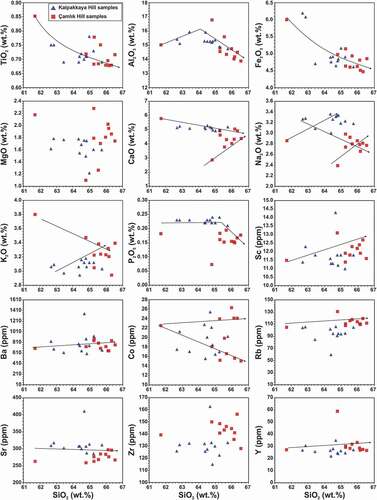
Figure 12. Chemical-stratigraphy of the Kalpakkaya and Çamlık Hill volcanics based on the major oxide chemistry
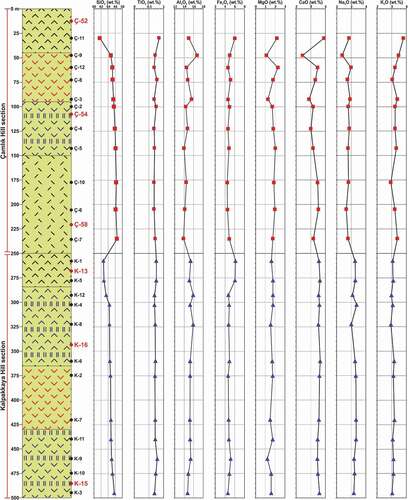
Figure 13. Chemical-stratigraphy of the Kalpakkaya and Çamlık Hill volcanics based on the trace elements
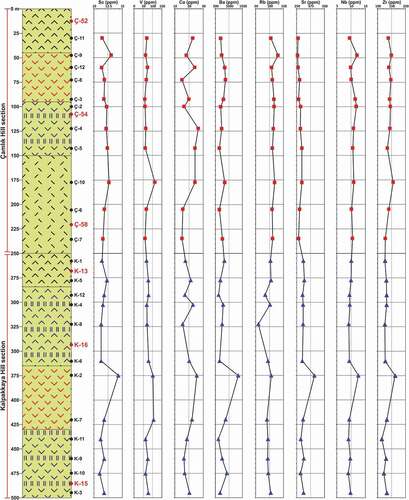
On the chemo-stratigraphy diagrams of the Kalpakkaya and Çamlıktepe Hill, it is observed that the trace elements (Sc, V, Co, Ba, Rb, Sr, Nb and Zr) follow a linear enrichment trend towards the middle levels of the section (). Sc, V, and Co elements are mainly used for the crystallisation of ferromagnesian minerals such as pyroxene and amphibole. Therefore, they are used to estimate the evolution of fractional crystallisation processes, and they gradually decrease during evolutionary processes in the transition from mafic to felsic magma in the magma chamber. Ba, Rb and Sr are mainly used to track the behaviour of the feldspar fractionation and they tend to get higher with the increasing SiO2 content. Rb together with Nb are also used to evaluate the behaviour of the mica phases, and they increase with increasing SiO2. Likewise, Zr tends to increase with increasing SiO2 content and is used to estimate the behaviour of the accessory phases (). Variations in trace element geochemistry, such as changes in the behaviour of major oxides, also indicate that the chemical composition of lavas did not significantly change over the period of its temporal evolution in the study area.
5. Discussion
5.1. Petrogenesis of volcanic rocks
We use the FC-Modeller software package of Keskin (Citation2002) to modelling the fractional crystallisation processes by using the Sr/Rb versus Sr elements (). For modelling parameters, Kd values compiled from GERM database and literature data, which are embedded in the FC-Modeller. In order to determine the crystal fractionation trends of plagioclase, sanidine, hornblende, biotite and zircon minerals, Rayleigh fractional crystallisation vectors were created by selecting intermediate and felsic magma compositions. The calculated crystallisation vectors show that the plagioclase, sanidine and biotite crystallisation is the dominant process while the amphibole and zircon crystallisation is less prominent. To explain the magma mixing and replenishment processes, creating a binary diagram that consists of a compatible element versus an incompatible element can give valuable insights about the magma evolution processes, and we created a Co versus Th diagram to track the possible mixing effects. If there is common fractional crystallisation related processes occurred, our samples would align along the FC-1 and FC-2 curves in . On the other hand, in the presence of an open system magma chamber where magma mixing and replenishment processes are effective together, the plotted samples are lined up along straight lines. When we check the plotted samples, some portion of our volcanic units follow the curved lines of FC-1 and FC-2, while a significant amount of the samples plots along the straight lines, which supports the possible existence of the magma mixing processes (mixing of mafic and felsic end members) through the evolution of the volcanism (). Even though the fractional crystallisation and magma mixing processes affected the magma composition in our samples, crustal assimilation can also affect the magmatic processes since our volcanic units display high silica contents. To reveal the possible assimilation processes, we used the assimilation-fractional crystallisation algorithms of DePaolo (Citation1981) that implement to the excel spreadsheet AFC-Modeller software by Keskin (Citation2013). We specifically select Ta/Zr and Zr values. The Ta/Zr ratios are used as an assimilation index while Zr values are interpreted as fractionation index (). For modelling scheme, we use the upper-crustal values of Taylor and McLennan (Citation1995) for an assimilant, and a calc-alkaline basalt from the Soma region (Ersoy et al., Citation2012b) as a basic end member (BEM) for the primitive lava composition (unpublished data; Zr: 58.1 ppm and Th: 0.2 ppm). The calculated vectors show that volcanic units plot along a linear trend from the BEM to assimilant, and Zr concentrations display quite similar patterns, which can be interpreted as the assimilation is much more prominent regarding the fractionation processes (r (Ma/Mc) = 0.4–0.7).
Figure 14. Several different magma modelling experiments have been done on the Kalpakkaya and Çamlık Hill volcanics to reveal the magma chamber/mush dynamics
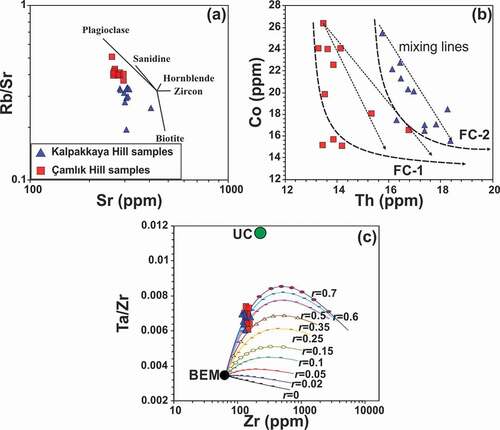
Magma source chemistry, volcano plumbing system and petrogenetic – geochronologic evolution of the study area and the surrounding areas have been investigated by different studies in the literature (Akay & Erdoğan, Citation2004; Altunkaynak et al., Citation2010; Borsi et al., Citation1972; Dönmez et al., Citation2017; Ercan et al., Citation1985; Fytikas et al., Citation1976; Hasözbek, Citation2017; Karaoğlu, Citation2014; Seghedi & Helvacı, Citation2016). The Miocene volcanic activity (Yuntdağ, Dumanlıdağ, Yamanlar, Foça, and Dikili volcanoes) in the Izmir Bay, west of the Menderes massif, are located within the Izmir – Balıkesir transfer zone (İBTZ). Yundağ volcanics are represented by calc-alkali volcanic rocks developed in this zone of weakness with NE – SW trending and they transition to lacustrine sediments in lateral and vertical directions. Although Akay and Erdoğan (Citation2004) suggested that the volcanic activity, which spreads over large areas in the region and forms large calderas, is related to stress tectonics, Karaoğlu (Citation2014) demonstrated the existence of a more complex mechanism that controls this volcanic activity. Karaoğlu (Citation2014) suggested that the western part of the Menderes Metamorphic Core Complex (MMCC) was affected by different deformation stages instead of İBTZ, and that early Miocene transtensional tectonics, middle Miocene extensional tectonics associated with slab-retreat and late Miocene tectonic block rotation controlled magma uplift at different stages.
The studies conducted in the recent years imply that the Cenozoic magmatism in the Western Anatolia was mainly controlled by the slab retreat and the roll-back. Different studies imply that the Early-Middle Miocene magmatism in the region was generated by the roll-back and rotation of the Hellenic – Cyprus slab, thinning of the continental crust, rupturing of the slab and transfer faults and block rotations in the upper crust control the pathways of the magma intrusive systems (Akal, Citation2019; Hasözbek, Citation2017; Karaoğlu, Citation2014; Seghedi & Helvacı, Citation2016; Uzel et al., Citation2020). Ersoy and Palmer (Citation2013) suggested that magmatism between the Eocene – Miocene periods was probably due to break-off of the subducted slab in western Anatolia. They argued that the Oligocene – Miocene magmatism was controlled by rotational extension in response to rotational roll-back of the Hellenic subduction system. Also, they underlined that this magmatism was closely associated with core complex formation and asthenosphere-related thermal input along a ~ N–S-trending slab tear beneath the Menderes Core Complex (Ersoy & Palmer, Citation2013). In a similar manner, different studies suggest that the roll-back of the Hellenic – Cyprus slab to the south/southeast through time also control the spatial-temporal and geochemical character of the magmatism in the region (Aysal, Citation2015; Borsi et al., Citation1972; Erkül et al., Citation2005; Ersoy et al., Citation2017; Fytikas et al., Citation1984; Innocenti et al., Citation2005; Karaoğlu, Citation2014; Pe-Piper & Piper, Citation1989).
The major portion of these studies imply that the volcanic and plutonic rocks in that region were generated by the fractionation, assimilation and magma mixing processes of the shallow seated magma batches that generated from the lithospheric mantle and mantle domains (Ersoy et al., Citation2010, 2012, Citation2017). Chemo-stratigraphic data from the volcanic units in the two sections of the south-eastern part of the Yuntdağ volcanics agrees with these previous studies. Our data imply that volcanism was fed by shallow seated magma chamber/mush that marked by fractional crystallisation, magma mixing and assimilation-related processes. Even though the complex shallow seated processes completely masked the original source chemistry, we tentatively postulated that our units possibly derived from melting of the mantle and/or subcontinental lithospheric mantle regions that triggered by the roll-back and rotation of the Hellenic – Cyprus slab during the Miocene period.
6. Conclusions
Thi study conducted in the south-eastern part of the Yuntdağ volcano that mainly focused on Kalpakkaya and Çamlık Hill sections show that the volcanic units in the region are mainly represented by dacitic, and andesitic lavas and tuff, which are intercalated with the sporadic Neogene sediments. Geochemistry of the volcanic rocks mainly shows high-K calc-alkaline character and displays volcanic arc and post-collisional tectonic settings. When all the geochemical data and models considered, it can be implying that the assimilation and magma mixing related processes are much more prominent compared to the fractional crystallisation related modifications, and/or possible continuous infiltration of the mafic or much primitive magma to the more felsic shallow seated magma chamber/mush to maintain the similar magmatic character. The chemo-stratigraphy sections suggest that 4 million years of variations implies no significant differences in magma composition and magma evolution processes, and this can be explained in two ways: (i) continuous feeding by a more mafic magma to balance the fractional crystallisation effect; (ii) homogenisation of mafic and intermediate magma during the evolution of volcanism and/or formation within an open system magma chamber.
Zircon U-Pb LA-ICP-MS ages from the Kalpakkaya Hill section show 17.64 ± 0.20, 17.22 ± 0.15 and 16.16 ± 0.17, Ma ages from bottom to top and Çamlık Hill section display 16.36 ± 0.13, 15.79 ± 0.71 and 13.61 ± 0.20 Ma (Lower – Middle Miocene) ages, which are compatible with the existing age data acquired around the region.
The volcanism in the region was generated and evolved under the influence of the roll-back/rotation of the Hellenic – Cyprus slab, and the pathways generated by the subsequent tectonic structures (İBTZ, core complex formation of Menderes Massif).
Acknowledgments
We thank the Editor Prof. Dr. Erdin Bozkurt, and two anonymous referees for helpful comments that have significantly improved this manuscript.
Disclosure statement
The authors declare no conflict of interest. The funders had no role in the design of the study; in the collection, analyses, or interpretation of data; in the writing of the manuscript, or in the decision to publish the results.
References
- Akal, C. (2019). Mechanism of emplacement and origin of the Ildır lava dome in the Karaburun Peninsula, western Anatolia (Turkey). Journal of Asian Earth Sciences, 179, 80–98. https://doi.org/https://doi.org/10.1016/j.jseaes.2019.04.012
- Akay, E., & Erdoğan, B. (2004). Evolution of Neogene calc-alkaline to alkaline volcanism in the Aliağa-Foça region (Western Anatolia, Turkey). Journal of Asian Earth Sciences, 24(3), 367–387. https://doi.org/https://doi.org/10.1016/j.jseaes.2004.01.015
- Akçay, A. E., Dönmez, M., & Türkecan, A. (2014). Türkiye jeoloji haritaları, URLA-K17 paftası. MTA Genel Müdürlüğü Yayını, n.212.
- Akyürek, B., & Soysal, Y. (1978). Kırkağaç-Soma (Manisa)-Savaştepe, Korucu, Ayvalık (Balıkesir)-Bergama (İzmir) civarının jeolojisi. MTA Enstitüsü (unpublished), rn. 6432
- Aldanmaz, E., Pearce, J. A., Thirlwall, M. F., & Mitchell, J. G. (2000). Petrogenetic evolution of late Cenozoic, post-collision volcanism in western Anatolia, Turkey. Journal of Volcanology and Geothermal Research, 102(1–2), 67–95. https://doi.org/https://doi.org/10.1016/S0377-0273(00)00182-7
- Altunkaynak, Ş., Dilek, Y., Genç, C. Ş., Sunal, G., Gertisser, R., Furnes, H., & Yang, J. (2012b). Spatial, temporal and geochemical evolution of Oligo–Miocene granitoid magmatism in western Anatolia, Turkey. Gondwana Research, 21(4), 961–986. https://doi.org/https://doi.org/10.1016/j.gr.2011.10.010
- Altunkaynak, Ş., Rogers, N. W., & Kelley, S. P. (2010). Causes and effects of geochemical variations in late Cenozoic volcanism of the Foça volcanic centre, NW Anatolia, Turkey. International Geology Review, 52(4–6), 579–607. https://doi.org/https://doi.org/10.1080/00206810903360455
- Altunkaynak, Ş., Sunal, G., Aldanmaz, E., Genç, C. Ş., Dilek, Y., Furnes, H., & Yıldız, M. (2012a). Eocene granitic magmatism in NW Anatolia (Turkey) revisited: New implications from comparative zircon SHRIMP U–Pb and 40Ar–39Ar geochronology and isotope geochemistry on magma genesis and emplacement. Lithos, 155, 289–309. https://doi.org/https://doi.org/10.1016/j.lithos.2012.09.008
- Aysal, N. (2015). Mineral chemistry, crystallization conditions and geodynamic implications of the Oligo–Miocene granitoids in the Biga Peninsula, Northwest Turkey. Journal of Asian Earth Sciences, 105, 68–84. https://doi.org/https://doi.org/10.1016/j.jseaes.2015.03.026
- Borsi, S., Ferrara, G., Innocenti, F., & Mazzuoli, R. (1972). Geochronology and petrology of recent volcanics in the Eastern Aegean Sea (West Anatolia and Lesvos Island). Bulletin Volcanologique, 36(3), 473–496. https://doi.org/https://doi.org/10.1007/BF02597122
- Bozkurt, E., & Park, R. G. (1994). Southern Menderes Massif: An incipient metamorphic core complex in western Anatolia, Turkey. Journal of the Geological Society, London, 151(2), 213–216. https://doi.org/https://doi.org/10.1144/gsjgs.151.2.0213
- Bozkurt, E., & Satır, M. (2000). The southern Menderes Massif (Western Turkey): Geochronology and exhumation history. Geological Journal, 35(3–4), 285–296. https://doi.org/https://doi.org/10.1002/gj.849
- Bozkurt, E., Satır, M., & Buğdaycıoğlu, Ç. (2011). Surprisingly young Rb/Sr ages from the Simav extensional detachment fault zone, northern Menderes Massif, Turkey. Journal of Geodynamic, 52(5), 406–431. https://doi.org/https://doi.org/10.1016/j.jog.2011.06.002
- Brinkmann, R. (1966). Geotektonische gliederung von Westanatolien (Stuttgart). N.Jb. Geol. Palaont Mh, 10, 603–618.
- Delaloye, M., & Bingöl, E. (2000). Granitoids from western and northwestern Anatolia: Geochemistry and modeling of geodynamic evolution. International Geology Review, 42(3), 241–268. https://doi.org/https://doi.org/10.1080/00206810009465081
- DePaolo, D. J. (1981). Trace element and isotopic effects of combined wallrock assimilation and fractional crystallization. Earth and Planetary Science Letters, 53(2), 189–202. https://doi.org/https://doi.org/10.1016/0012-821X(81)90153-9
- Dönmez, M., Akçay, A. E., & Türkecan, A. (2014). 1/100000 ölçekli Türkiye Jeoloji Haritaları, İzmir K18 Paftası, MTA Genel Müdürlüğü, n. 23.
- Dönmez, M., Akçay, A. E., & Türkecan, A. (2017). Batı Anadolu’da yeni bir kaldera: Foça kalderası. Dogal Kaynaklar Ve Ekonomi Bülteni, 24, 13–20.
- Dönmez, M., Türkecan, A., Akçay, A. E., Hakyemez, Y., & Sevin, D. (1998). İzmir ve kuzeyinin jeolojisi Tersiyer volkanizmasının petrografik ve kimyasal özellikleri. MTA Genel Müdürlüğü (yayımlanmamış), pn. 10181.
- Emre, T., & Sözbilir, H. (1995). Field evidence for metamorphic core complex, detachment faulting and accommodation faults in the Gediz and Büyük Menderes grabens, western Anatolia. IESCA-Proceedings, 1, 73–93.
- Ercan, T., Satır, M., Kreuzer, H., Türkecan, A., Günay, E., Çevikbaş, A., Ateş, M., & Can, B. (1985). Batı Anadolu Senozoyik volkanitlerine ait yeni kimyasal, izotopik ve radyometrik verilerin yorumu (The interpretation of new chemical, isotopic and geochronologic data from the Cenozoic volcanics of western Turkey). Bull. Geol. Soc. Of Turk, 28, 121–136.
- Ercan, T., Satır, M., Sevin, D., & Türkecan, A. (1996). Batı Anadolu’daki Tersiyer ve Kuvaterner yaşlı volkanik kayaçlarda yeni yapılan radyometrik yaş ölçümlerinin yorumu (Some new radiometric ages from Tertiary and Quaternary volcanic rocks fromWest Anatolia). Bull. Miner. Res. Explor. Inst. Turk, 119, 103–112.
- Erdoğan, B. (1990). İzmir-Ankara Zonu’nun İzmir-Seferihisar arasındaki bölgede stratigrafik özellikleri ve tektonik evrimi. TP Jeologlari Dernegi Bülteni, 2/1, 1–20.
- Erkül, F., Helvaci, C., & Sözbilir, H. (2005). Stratigraphy and Geochronology of the Early Miocene Volcanic Units in the Bigadiç Borate Basin, Western Turkey. Turkish Journal of Earth Sciences, 14(3), 227–253.
- Ersoy, E. Y., Dindi, F., Karaoğlu, Ö., & Helvacı, C. (2012b). Geochemical and Petrographic Features of the Miocene Volcanism Around Soma Basin, Western Anatolia, Turkey. Bulletin of the Earth Sciences Application and Research Centre of Hacettepe University, 33(1), 59–80.
- Ersoy, E. Y., Helvacı, C., & Palmer, M. R. (2010). Mantle source characteristics and melting models for the early-middle Miocene mafic volcanism in Western Anatolia: Implications for enrichment processes of mantle lithosphere and origin of K-rich volcanism in postcollisional settings. J. Volcanol. Geotherm. Res, 198(1–2), 112–128. https://doi.org/https://doi.org/10.1016/j.jvolgeores.2010.08.014
- Ersoy, E. Y., Helvacı, C., Uysal, İ., Karaoğlu, Ö., Palmer, M. R., & Dindi, F. (2012a). Petrogenesis of the Miocene volcanism along the İzmir–Balıkesir Transfer Zone in western Anatolia, Turkey: Implications for origin and evolution of potassic volcanism in postcollisional areas. J. Volcanol. Geotherm. Res, 241–242, 21–38. https://doi.org/https://doi.org/10.1016/j.jvolgeores.2012.05.022
- Ersoy, E. Y., & Palmer, M. R. (2013). Eocene-Quaternary magmatic activity in the Aegean: Implications for mantle metasomatism and magma genesis in an evolving orogeny. Lithos, 180, 5–24. https://doi.org/https://doi.org/10.1016/j.lithos.2013.06.007
- Ersoy, E. Y., Palmer, M. R., Genç, Ş. C., Prelević, D., Akal, C., & Uysal, İ. (2017). Chemo-probe into the mantle origin of the NW Anatolia Eocene to Miocene volcanic rocks: Implications for the role of subduction, slab roll-back and slab break-off processes in genesis of post-collisional magmatism. Lithos, 288–289, 55–71. https://doi.org/https://doi.org/10.1016/j.lithos.2017.07.006
- Ersoy, E.Y., Helvacı, C., Sözbilir, H., Erkül, F., Bozkurt, E. 2008. A geochemical approach to Neogene–Quaternary volcanic activity of western Anatolia: an example of episodic bimodal volcanism within the Selendi Basin, Turkey. Chemical Geology, 255 (1–2), 265–282.
- Eşder, T., Yakabağ, A., Sarıkaya, H., & Çiçekli, K. (1991). Aliağa (İzmir) yöresinin jeolojisi ve jeotermal enerji olanakları. MTA Genel Müdürlüğü (yayımlanmamış), n. 9467.
- Fytikas, M., Giuliani, O., Innocenti, F., Marinelli, G., & Mazzuoli, R. (1976). Geochronological data on Recent magmatism of the Aegean Sea. Tectonophysics, 31(1–2), 29–34. https://doi.org/https://doi.org/10.1016/0040-1951(76)90161-X
- Fytikas, M., Innocenti, F., Manetti, P., Peccerillo, A., Mazzuoli, R., & Villari, L. (1984). Tertiary to Quaternary evolution of volcanism in the Aegean region. Geological Society, London, Special Publications, 17(1), 687–699. https://doi.org/https://doi.org/10.1144/GSL.SP.1984.017.01.55
- Gessner, K., Ring, U., Johnson, C., Hetzel, R., Passchier, C. W., & Güngör, T. (2001). An active bivergent rolling-hinge detachment system: Central Menderes metamorphic core complex in western Turkey. Geology, 29(7), 611–614. https://doi.org/https://doi.org/10.1130/0091-7613(2001)029<0611:AABRHD>2.0.CO;2
- Grützner, T., Prelević, D., & Akal, C. (2013). Geochemistry and origin of ultramafic enclaves and their basanitic host rock from Kula Volcano, Turkey. Lithos, 180, 58–73. https://doi.org/https://doi.org/10.1016/j.lithos.2013.08.001
- Harris, M., Mackender, R. O., & Smith, D. L. (1986). Photosynthesis of cotyledons of soybean seedlings. New Phytologist, 104(3), 319–329. https://doi.org/https://doi.org/10.1111/j.1469-8137.1986.tb02899.x
- Hasözbek, A. (2017). Dursunbey (Balıkesir)-Foça (İzmir) Erken-Orta Miyosen Volkaniklerinin İzotop Jeokimyası. D.Ü. Mühendislik Fakültesi Fen Ve Mühendislik Dergisi, 19(57), 950–967. https://doi.org/https://doi.org/10.21205/deufmd.2017195783
- Helvacı, C., Ersoy, E. Y., Sözbilir, H., Erkül, F., Sümer, Ö., & Uzel, B. (2009). Geochemistry and 40Ar/39Ar geochronology of Miocene volcanic rocks from the Karaburun Peninsula: Implications for amphibole-bearing lithospheric mantle source, Western Anatolia. Journal of Volcanology and Geothermal Research, 185(3), 181–202. https://doi.org/https://doi.org/10.1016/j.jvolgeores.2009.05.016
- Innocenti, F., Agostini, S., Di Vincenzo, G., Doglioni, C., Manetti, P., Savaşçın, M. Y., & Tonarini, S. (2005). Neogene and Ouaternary volcanism in Western Anatolia: Magma sources and geodynamic evo¬lution. Marine Geology, 221, 397–421.
- Jolivet, L., & Brun, J.-P. (2010). Cenozoic geodynamic evolution of the Aegean. International Journal of Earth Science, 99, 109–138.
- Jolivet, L., Faccenna, C., Huet, B., Labrousse, L., Le Pourhiet, L., Lacombe, O., & Philippon, M. (2013). Aegean tectonics: Strain localisation, slab tearing and trench retreat. Tectonophysics, 597, 1–33.
- Karaoğlu, Ö. (2014). Tectonic controls on the Yamanlar volcano and Yuntdağ volcanic region, western Turkey: Implications for an incremental deformation. Journal of Volcanology and Geothermal Research, 274, 16–33. https://doi.org/https://doi.org/10.1016/j.jvolgeores.2014.01.013
- Kaya, O. (1978). Ege kıyı kuşağı (Dikili-Zeytindağı-Menemen-Yenifoça) Neojen stratigrafisi. EÜ Fen Fakültesi, p. 17.
- Keskin, M. (2002). FC-modeler: A Microsoft® Excel© spreadsheet program for modeling Rayleigh fractionation vectors in closed magmatic systems. Computers & Geosciences, 28(8), 919–928. https://doi.org/https://doi.org/10.1016/S0098-3004(02)00010-9
- Keskin, M. (2013). AFC-Modeler: A Microsoft® Excel© Workbook Program for Modelling Assimilation combined with Fractional Crystallization (AFC) Process in Magmatic Systems by Using Equations of DePaolo (1981). Turkish Journal of Earth Sciences, 22, 304–319.
- Köprübaşı, N., & Aldanmaz, E. (2004). Geochemical constraints on the petrogenesis of Cenozoic I-type granitoids in Northwest Anatolia, Turkey: Evidence for magma generation by lithospheric delamination in a post-collisional setting. International Geology Review, 46(8), 705–729. https://doi.org/https://doi.org/10.2747/0020-6814.46.8.705
- Le Bas, M. J., Le Maitre, R. W., Streckeisen, A., & Zanettin, B. (1986). A chemical classification of volcanic rocks based on the total alkali-silica diagram. Journal of Petrology, 27(3), 745–750. https://doi.org/https://doi.org/10.1093/petrology/27.3.745
- Okay, A. I., & Altıner, D. (2007). A condensed Mesozoic section in the Bornova Flysch Zone: A fragment of the Anatolide-Tauride carbonate platform. Turkish Journal of Earth Sciences, 16, 257–279.
- Okay, A. I., İşintek, İ., Altıner, D., Özkan-Altıner, S., & Okay, N. (2012). An olistostrome–mélange belt formed along a suture: Bornova Flysch zone, western Turkey. Tectonophysics, 568, 282–295. https://doi.org/https://doi.org/10.1016/j.tecto.2012.01.007
- Okay, A. I., & Tüysüz, O. (1999). Tethyan sutures of northern Turkey. Geological Society, London, Special Publications, 156(1), 475–515. https://doi.org/https://doi.org/10.1144/GSL.SP.1999.156.01.22
- Paton, C., Hellstrom, J., Paul, B., Woodhead, J., & Hergt, J. (2011). Iolite: Freeware for the visualisation and processing of mass spectrometric data. Journal of Analytical Atomic Spectrometry, 26(12), 2508–2518. https://doi.org/https://doi.org/10.1039/c1ja10172b
- Pearce, J. A., Harris, N. B., & Tindle, A. G. (1984). Trace element discrimination diagrams for the tectonic interpretation of granitic rocks. Journal of Petrology, 25(4), 956–983. https://doi.org/https://doi.org/10.1093/petrology/25.4.956
- Peccerillo, A., & Taylor, S. R. (1976). Geochemistry of Eocene calc-alkaline volcanic rocks from the Kastamonu area, northern Turkey. Contributions to Mineralogy and Petrology, 58(1), 63–81. https://doi.org/https://doi.org/10.1007/BF00384745
- Pe-Piper, G., & Piper, D. J. (1989). Spatial and temporal variation in Late Cenozoic back-arc volcanic rocks, Aegean Sea region. Tectonophysics, 169(1–3), 113–134. https://doi.org/https://doi.org/10.1016/0040-1951(89)90186-8
- Prelević, D., Akal, C., Foley, F., Romer, R. L., Stracke, A., & Van Den Bogaard, P. (2012). Ultrapotassic mafic rocks as geochemical proxies for post-collisional dynamics of orogenic lithospheric mantle: The case of southwestern Anatolia, Turkey. Journal of Petrology, 53(5), 1019–1055. https://doi.org/https://doi.org/10.1093/petrology/egs008
- Ring, U., Glodny, J., Will, T., & Thomson, S. (2010). The Hellenic subduction system: High-pressure metamorphism, exhumation, normal faulting, and large-scale extension. Annual Review of Earth and Planetary Sciences, 38(1), 45–76. https://doi.org/https://doi.org/10.1146/annurev.earth.050708.170910
- Schandl, E.S., and Gorton, M.P., 2002, Application of high field strength elements to discriminate tectonic settings in VMS environments: Economic Geology, 97, 629–642. https://doi.org/https://doi.org/10.2113/gsecongeo.97.3.629
- Seghedi, I., & Helvacı, C. (2016). Early Miocene Kırka-Phrigian Caldera, western Turkey (Eskişehir province), preliminary volcanology, age and geochemistry data. Journal of Volcanology and Geothermal Research, 327, 503–519. https://doi.org/https://doi.org/10.1016/j.jvolgeores.2016.09.007
- Şengör, A. M. C., & Yılmaz, Y. (1981). Tethyan evolution of Turkey: A plate tectonic approach. Tectonophysics, 75(3–4), 181–241. https://doi.org/https://doi.org/10.1016/0040-1951(81)90275-4
- Sun, S. S., & MacDonough, W. F. (1989). Chemical and isotopic systematics of oceanic basalts: Implications for mantle composition and processes. Geological Society of London Special Publication, 42(1), 313–345. https://doi.org/https://doi.org/10.1144/GSL.SP.1989.042.01.19
- Tatar Erkül, S., Erkül, F., & Aysal, N. (2018, Vol. 126, Number). Evidence for continuous mixing of individually fractionated, coeval felsic and mafic magmas forming synextensional plutons, the Menderes Core Complex, Western Turkey. The Journal of Geology, (5), 1–24. .
- Taylor, S. R., & McLennan, S. M. (1995). The geochemical evolution of the continental crust. Reviews of Geophysics, 33(2), 241–265. https://doi.org/https://doi.org/10.1029/95RG00262
- Tokçaer, M., Agostini, S., & Savaşçin, M. Y. (2005). Geotectonic setting and origin of the youngest Kula volcanics (western Anatolia), with a new emplacement model. Turkish Journal of Earth Sciences, 14(2), 143–166.
- Türkecan, A. (2015). Türkiye’nin Senozoyik Volkanitleri. MTA Genel Müdürlüğü Özel Yayın Serisi, n. 33.
- Ustaömer, P. A., Ustaömer, T., Collins, A. S., & Reischpeitsch, J. (2009). Lutetian arc-type magmatism along the southern Eurasian margin: New U-Pb LA-ICPMS and whole-rock geochemical data from Marmara Island, NW Turkey. Mineralogy and Petrology, 96(3–4), 177–196. https://doi.org/https://doi.org/10.1007/s00710-009-0051-8
- Üşümezsoy, Ş. (1988). Evolution of the NW Anatolian Pb-Zn deposits: Litospheric detachment in compressional and extensional regime in NW Anatolian accretionary belt magmatism and metallogenesis. Geosound, 177, 1–34.
- Uzel, B., Kuiper, K., Sözbilir, H., Kaymakci, N., Langereis, C. G., & Boehm, K. (2020). Miocene geochronology and stratigraphy of western Anatolia: Insights from new Ar/Ar dataset. Lithos, 352, 105305. https://doi.org/https://doi.org/10.1016/j.lithos.2019.105305
- Uzel, B., Sözbilir, H., Özkaymak, Ç., Kaymakcı, N., & Langereis, C. G. (2013). Structural evidence for strike-slip deformation in the İzmir–Balıkesir transfer zone and consequences for late Cenozoic evolution of western Anatolia (Turkey). Journal of Geodynamics, 65, 94–116. https://doi.org/https://doi.org/10.1016/j.jog.2012.06.009
- Van Hinsbergen, D. J. J., Dekkers, M. J., Bozkurt, E., & Koopman, M. (2010). Exhumation with a twist: Paleomagnetic constraints on the evolution of the Menderes metamorphic core complex, western Turkey. Tectonics, 29(3), TC3009. https://doi.org/https://doi.org/10.1029/2009TC002596
- Van Hinsbergen, D. J. J., Hafkenscheid, E., Spakman, W., Meulenkamp, J. E., & Wortel, R. (2005). Nappe stacking resulting from subduction of oceanic and continental lithosphere below Greece. Geology, 33(4), 325–328. https://doi.org/https://doi.org/10.1130/G20878.1

